Elemental Composition, Rock-Magnetic Characterization, and Archaeomagnetic Dating of Ceramic Fragments from the Paquimé Archaeological Site (Northern Mexico)
Abstract
1. Introduction
2. Materials
2.1. Geological Background
2.2. Pottery Samples
3. Methodologies
3.1. X-Ray Fluorescence
3.2. Rock-Magnetic Characterization and Archaeointensity Experiments
3.3. Archaeomagnetic Dating
4. Results
4.1. Elemental Composition
4.2. Rock-Magnetic Characterization
4.3. Archaeointensity Determinations
4.4. Archaeointensity Dating
5. Discussion
6. Conclusions
Author Contributions
Funding
Data Availability Statement
Acknowledgments
Conflicts of Interest
Abbreviations
| ATRM | Anisotropy of thermoremanent magnetization |
| AI | Archaeointensity |
| CR | Cooling rate |
| MD | Multi-domain |
| Probability density function | |
| pTRM | Partial thermoremanence |
| XRF | X-Ray fluorescence |
References
- Whalen, M.E.; Minnis, P.E. The Casas Grandes Regional System: A Late Prehistoric Polity of Northwestern Mexico. J. World Prehistory 2001, 15, 313–364. [Google Scholar] [CrossRef]
- Rakita, G. Ancestors and Elites: Emergent Complexity and Ritual Practices in the Casas Grandes Polity; Archaeology of Religion Series; Altamira Press: New York, NY, USA, 2009; Volume 6. [Google Scholar]
- Di Peso, C. Volume 1 Casas Grandes Preceramic, Plainware and Viejo Periods. In Casas Grandes: A Fallen Trading Center of the Gran Chichimeca; Fenner, G.J., Ed.; Wesche, A., Illustrator; The Amerind Foundation, Inc./Dragoon Northland Press: Fragstaff, AZ, USA, 1974. [Google Scholar]
- Di Peso, C. Volume 2 The Medio Period. In Casas Grandes: A Fallen Trading Center of the Gran Chichimeca; Fenner, G.J., Ed.; Wesche, A., Illustrator; The Amerind Foundation, Inc./Dragoon Northland Press: Fragstaff, AZ, USA, 1974. [Google Scholar]
- Di Peso, C. Volume 3 The Tardio Period. In Casas Grandes: A Fallen Trading Center of the Gran Chichimeca; Fenner, G.J., Ed.; Wesche, A., Illustrator; The Amerind Foundation, Inc./Dragoon Northland Press: Fragstaff, AZ, USA, 1974. [Google Scholar]
- Mathiowetz, M.D. “El hijo de Dios que está en el sol”: Autoridad política y personificación del Dios Sol en el antiguo Noroccidente de México. In Aztatlán, Interacción y Cambio Social en el Occidente de México ca. 850–1350 d.C.; Valverde, L.S., Nelson, B.A., Eds.; El Colegio de Michoacán, A.C., Arizona State University: Zapopan, Jalisco, Mexico, 2019; pp. 287–318. [Google Scholar]
- Dean, J.S.; Ravesloot, J.C. The Chronology of Cultural Interaction in the Gran Chichimeca. In Culture and Contact: Charles C. Di Peso’s Gran Chichimeca; Woosley, A.I., Ravesloot, J.C., Eds.; Amerind Foundation: Dragoon, AZ, USA, 1993; pp. 83–103. [Google Scholar]
- Di Peso, C.; Rinaldo, J.; Fenner, G. Volume 7 Stone and Metal. In Casas Grandes: A Fallen Trading Center of the Gran Chichimeca; Wesche, A., Illustrator; The Amerind Foundation, Inc./Dragoon Northland Press: Fragstaff, AZ, USA, 1974. [Google Scholar]
- Whalen, M.; MacWilliams, A.; Pitezel, T. Reconsidering the Size and Structure of Casas Grandes, Chihuahua, Mexico. Am. Antiq. 2010, 75, 527–551. [Google Scholar] [CrossRef]
- Braniff, B.C. Paquimé; Fondo de Cultura Económica: Mexico City, Mexico, 2008. [Google Scholar]
- Posada, C.L.; Reyes, A.Y. Ruinas de Paquimé: Cronología de su historia y desarrollo. In Inventario De Monumentos, Edificios Y Sitios: Históricos y Relevantes Del Noroeste De Chihuahua Período 700 a 1900; Grupo de Pesquisas Em Lazer, Turismo e Trabalho, GEPLAT-UERN: Mossoró, Brasil, 2020; pp. 38–63. [Google Scholar]
- Braniff, B.C. Paquimé; Fondo de Cultura Económica: Mexico City, Mexico, 2016; p. 139. [Google Scholar]
- Nelson, B.A.; Canchola, E.V.; Díaz, J.L.P.; Minnis, P.E. Prehispanic Northwest and Adjacent West Mexico, 1200 B.C.–A.D. 1400: An Inter-Regional Perspective. KIVA 2015, 81, 31–61. [Google Scholar] [CrossRef]
- Madingou, B.T.; Perrin, M.; Hervé, G.; Cardona, A.H.; Alva-Valdivia, L.M.; Antillón, R.C. First full vector archeomagnetic data from Northern Mexico. Geochem. Geophys. Geosyst. 2021, 22, e2021GC009969. [Google Scholar] [CrossRef]
- Alva-Valdivia, L.M.; Rodríguez-Trejo, A.; Cruz-Antillón, R.; Hervé, G.; Perrin, M.; Salgado-Saito, M.M.; Mahgoub, A.N. Archaeomagnetic dating and magnetic characterization of ceramics from the Paquimé, Casas Grandes region, Chihuahua, Mexico. J. Archaeol. Sci. Rep. 2021, 37, 103040. [Google Scholar] [CrossRef]
- Goguitchaichvili, A.; Carrera, E.P.G.; Galván, M.; Morales, J.; Cejudo, R.; Cervantes, M.; Kravchinsky, V.; García-Ruiz, R.; Bautista, F.; Punzo, J.L. Magnetic signature of deep pit ovens from Paquimé, ceremonial center of the Casas Grandes culture (Northern Mexico). J. South Am. Earth Sci. 2024, 149, 105190. [Google Scholar] [CrossRef]
- Doyel, D.E.; Haury, E.W. Summary of Conference Discussion. KIVA 1976, 42, 127–134. [Google Scholar] [CrossRef]
- Crow, P. Ceramics and Ideology: Salado Polychrome Pottery; University of New Mexico Press: Albuquerque, NM, USA, 1994. [Google Scholar]
- Carta Geológica Nuevo Casas Grandes H13-4, 1:250,000; SGM: Ciudad de México, Mexico, 2002.
- Offenbecker, A.M. Geographic Origins, Status, and Identity at Paquimé, Northwest Chihuahua, Mexico. Ph.D. Thesis, University of Calgary, Calgary, AB, Canada, 2018. [Google Scholar]
- Brouwer, P. Theory of XRF Getting Acquainted with the Principle, 3rd ed.; PANalytical BV: Almelo, The Netherlands, 2010. [Google Scholar]
- Loponte, D.; Morales, J.; Gogichaishvili, A.; Acosta, A. Chemical characterization of archaeological pottery of the Lower Paraná River. Cerâmica 2019, 65, 319–326. [Google Scholar] [CrossRef]
- Thellier, E.; Thellier, O. Sur l’intensite du champ magnétique terrestre dans le passé historique et géologique. Ann. Geophys. 1959, 15, 285–376. [Google Scholar]
- Coe, R.S.; Gromme, S.; Mankinen, E.A. Geomagnetic paleointensities from radiocarbon-dated lava flows on Hawaii and the question of the Pacific nondipole low. J. Geophys. Res. 1978, 83, 1740–1756. [Google Scholar] [CrossRef]
- Riisager, P.; Riisager, J. Detecting multidomain magnetic grains in Thellier palaeointensity experiments. Phys. Earth Planet. Inter. 2001, 125, 111–117. [Google Scholar] [CrossRef]
- Veitch, R.J.; Hedley, I.G.; Wagner, J.J. An investigation of the intensity of the geomagnetic field during Roman times using magnetically anisotropic bricks and tiles. Arch. Sci. Geneve. 1984, 37, 359–373. [Google Scholar]
- Chauvin, A.; Garcia, Y.; Lanos, P.; Laubenheimer, F. Paleointensity of the geomagnetic field recovered on archaeomagnetic sites from France. Phys. Earth Planet. Inter. 2000, 120, 111–136. [Google Scholar] [CrossRef]
- Morales, J.; Goguitchaichvili, A.; Acosta, G.; González-Moran, T.; Alva-Valdivia, L.; Robles-Camacho, J.; Hernández-Bernal, M.d.S. Magnetic properties and archeointensity determination on Pre-Columbian pottery from Chiapas, Mesoamerica. Earth Planets Space 2009, 61, 83–91. [Google Scholar] [CrossRef]
- Béguin, A.; Paterson, G.; Biggin, A.J.; de Groot, L.V. Paleointensity.org: An Online, Open Source, Application for the Interpretation of Paleointensity Data. Geochem. Geophys. Geosystems 2020, 21, e2019GC008791. [Google Scholar] [CrossRef]
- Pavón-Carrasco, F.J.; Rodríguez-Gonzalez, J.; Osete, M.L.; Torta, J.M. A Matlab tool for archeomagnetic dating. J. Archaeol. Sci. 2011, 38, 408–419. [Google Scholar] [CrossRef]
- Mahgoub, A.N.; Juárez-Arriaga, E.; Böhnel, H.; Siebe, C.; Pavón-Carrasco, F.J. Late-Quaternary secular variation data from Mexican volcanoes. Earth Planet. Sci. Lett. 2019, 519, 28–39. [Google Scholar] [CrossRef]
- Di Peso, C. Gila Polychrome in the Casas Grandes Region. KIVA 1976, 42, 56–63. [Google Scholar] [CrossRef]



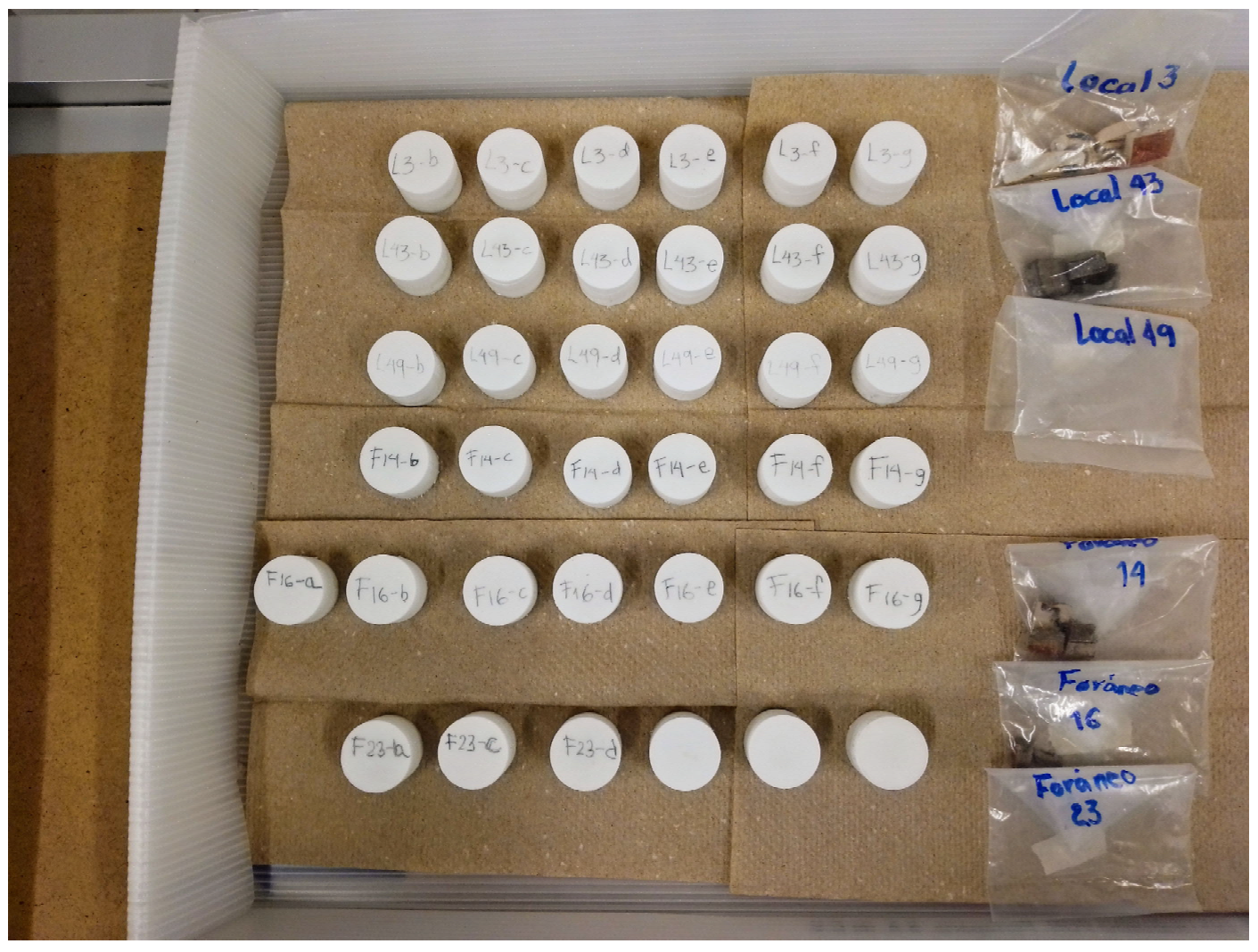
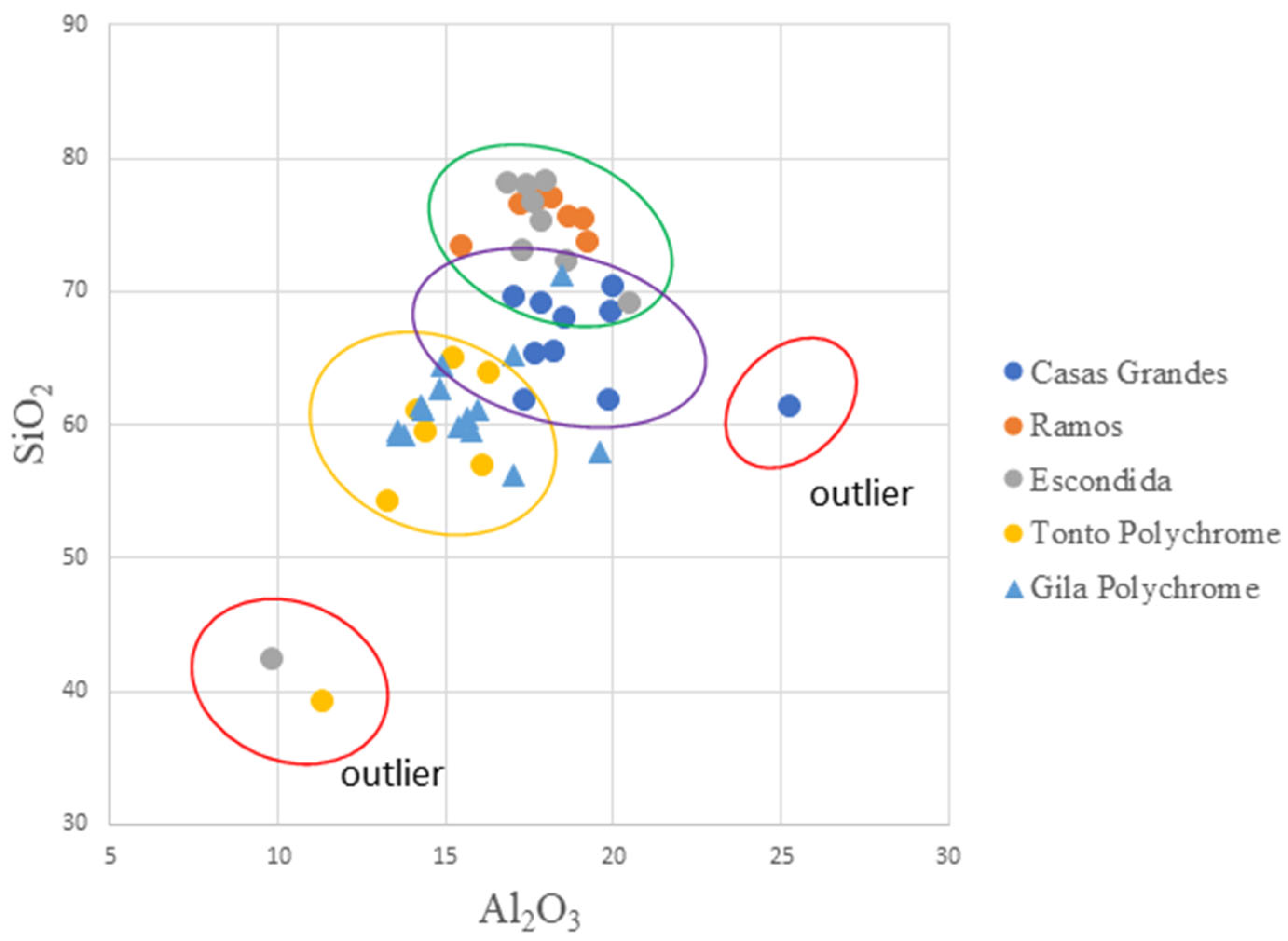



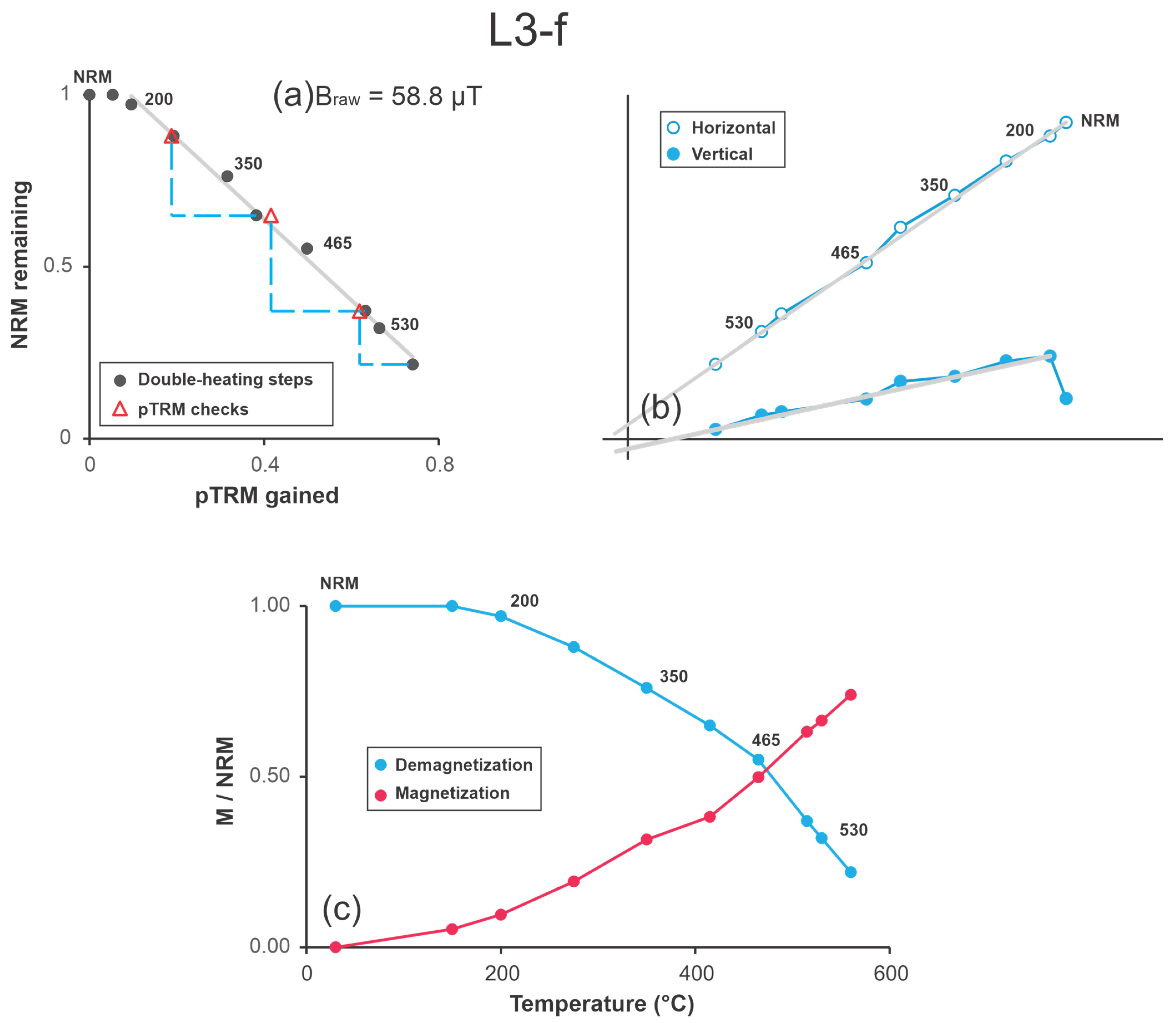
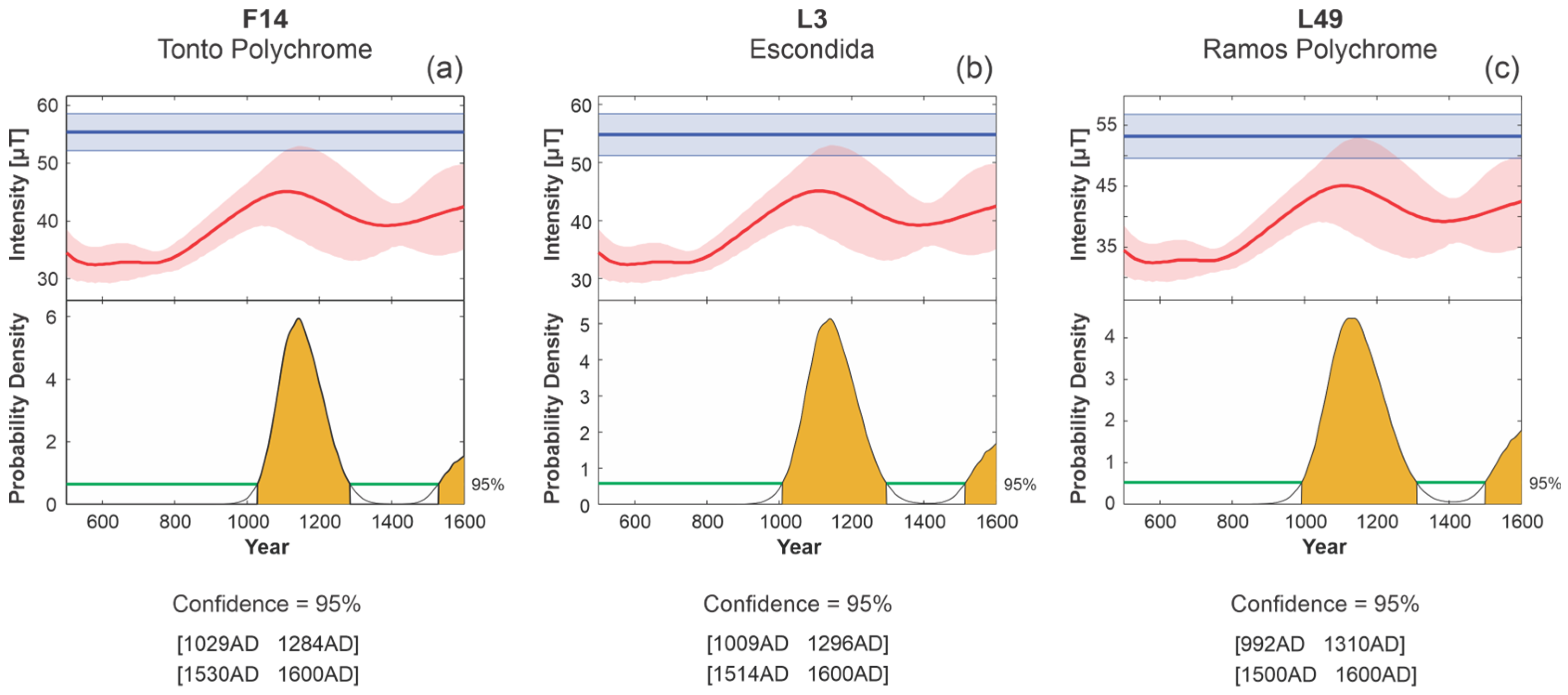
| Salado Polychrome Ware | Period | Technology | Forms | Decorative Styles |
|---|---|---|---|---|
Gila Polychrome | 1300–1450 d. C. | Distinct slips
| Bowl and jar |
|
Tonto Polychrome | 1300–1450 d. C. | Jar, bowl, and bird effigy jar |
| |
| Casas Grandes Polychrome Ware | Period | Technology | Forms | Decorative Styles |
| Escondida Polychrome Gila Variant  | 1300–1450 d. C. | Soft thin red slip or wash
| Jar, bowl, bird effigy jar, and human effigy jar |
|
Ramos Polychrome | 1300–1450 d. C. | Self-slip
| Jar, bowl, bird effigy jar, human effigy jar, and Tecomate |
|
| Casas Grandes Utility Ware | Period | Technology | Forms | Decorative Styles |
Casas Grandes Plainware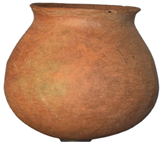 | 1200–1450 d. C. | Polished surfaces Oxidizing fire
| Jar, bowl, bird effigy jar, human effigy jar, and Tecomate |
|
| Na2O | MgO | Al2O3 | SiO2 | P2O5 | K2O | CaO | TiO2 | MnO | Fe2O3 | Σ | |
|---|---|---|---|---|---|---|---|---|---|---|---|
| Casas Gdes. | |||||||||||
| 39 | 2.36 | 1.83 | 19.91 | 68.63 | 0.07 | 3.79 | 1.57 | 0.72 | 0.04 | 3.69 | 102.6 |
| 40 | 1.24 | 2.98 | 18.52 | 68.11 | 0.07 | 3.50 | 1.82 | 0.51 | 0.05 | 3.88 | 100.7 |
| 41 | 1.86 | 1.28 | 25.23 | 61.37 | 0.44 | 3.01 | 1.19 | 0.73 | 0.05 | 4.96 | 100.1 |
| 42 | 1.60 | 1.56 | 17.81 | 69.16 | 0.28 | 4.08 | 1.45 | 0.30 | 0.04 | 4.72 | 101.0 |
| 43 | 1.68 | 2.26 | 17.31 | 61.90 | 0.50 | 4.30 | 1.48 | 0.79 | 0.08 | 5.73 | 96.0 |
| 44 | 1.55 | 2.21 | 19.83 | 61.89 | 0.64 | 2.58 | 3.25 | 0.74 | 0.06 | 5.07 | 97.8 |
| 45 | 1.49 | 2.23 | 17.04 | 69.69 | 0.16 | 3.43 | 1.84 | 0.52 | 0.05 | 4.16 | 100.6 |
| 46 | 1.50 | 1.24 | 19.94 | 70.49 | 0.05 | 4.64 | 1.08 | 0.42 | 0.03 | 3.41 | 102.8 |
| 47 | 1.81 | 1.46 | 18.22 | 65.51 | 0.24 | 3.87 | 1.18 | 0.44 | 0.05 | 5.71 | 98.5 |
| 48 | 1.83 | 1.19 | 17.68 | 65.34 | 0.25 | 3.89 | 1.02 | 0.43 | 0.04 | 5.34 | 97.0 |
| Mean = | 1.7 | 1.8 | 19.1 | 66.2 | 0.3 | 3.7 | 1.6 | 0.6 | 0.05 | 4.7 | |
| 1 σ = | 0.3 | 0.6 | 2.4 | 3.5 | 0.2 | 0.6 | 0.7 | 0.2 | 0.01 | 0.8 | |
| Ramos | |||||||||||
| 51 | 1.58 | 1.42 | 19.19 | 73.83 | 0.03 | 4.65 | 0.76 | 0.40 | 0.05 | 2.54 | 104.4 |
| 52 | 1.52 | 2.08 | 19.12 | 75.49 | 0.12 | 4.39 | 0.89 | 0.28 | 0.04 | 1.69 | 105.6 |
| 53 | 1.56 | 2.25 | 17.19 | 76.61 | 0.08 | 3.99 | 1.01 | 0.29 | 0.05 | 2.68 | 105.7 |
| 54 | 1.77 | 1.58 | 18.17 | 77.07 | 0.04 | 4.46 | 1.00 | 0.18 | 0.05 | 1.29 | 105.6 |
| 55 | 1.57 | 1.74 | 15.48 | 73.51 | 0.05 | 3.98 | 0.83 | 0.33 | 0.05 | 3.03 | 100.6 |
| 56 | 2.02 | 2.01 | 18.67 | 75.66 | 0.05 | 4.64 | 0.90 | 0.27 | 0.05 | 1.61 | 105.9 |
| 57 | 2.33 | 1.27 | 17.73 | 76.97 | 0.18 | 4.46 | 0.83 | 0.18 | 0.05 | 1.71 | 105.7 |
| Mean = | 1.8 | 1.8 | 17.9 | 75.6 | 0.1 | 4.4 | 0.9 | 0.3 | 0.05 | 2.1 | |
| 1 σ = | 0.3 | 0.4 | 1.3 | 1.4 | 0.1 | 0.3 | 0.1 | 0.1 | 0.00 | 0.7 | |
| Escondida | |||||||||||
| 4 | 1.45 | 1.69 | 17.83 | 75.30 | 0.03 | 4.35 | 0.81 | 0.32 | 0.04 | 2.51 | 104.3 |
| 5 | 1.89 | 1.34 | 17.95 | 78.43 | 0.02 | 4.34 | 0.81 | 0.28 | 0.04 | 1.97 | 107.1 |
| 6 | 1.80 | 1.29 | 16.82 | 78.24 | 0.04 | 4.16 | 1.11 | 0.26 | 0.05 | 2.02 | 105.8 |
| 7 | 1.82 | 1.10 | 17.57 | 76.74 | 0.37 | 4.54 | 0.92 | 0.27 | 0.05 | 1.95 | 105.3 |
| 8 | 1.82 | 1.56 | 20.46 | 69.15 | 0.07 | 4.58 | 0.92 | 0.52 | 0.06 | 2.78 | 101.9 |
| 9 | 1.47 | 1.57 | 17.27 | 73.11 | 0.03 | 4.99 | 1.09 | 0.29 | 0.05 | 1.87 | 101.7 |
| 10 | 0.91 | 1.72 | 9.78 | 42.47 | 0.30 | 3.04 | 17.41 | 0.44 | 0.02 | 2.95 | 79.0 |
| 11 | 1.89 | 1.94 | 18.61 | 72.32 | 0.21 | 4.47 | 0.92 | 0.45 | 0.05 | 2.56 | 103.4 |
| 12 | 1.77 | 1.19 | 17.37 | 77.98 | 0.01 | 4.53 | 0.88 | 0.17 | 0.05 | 1.29 | 105.2 |
| Mean = | 1.6 | 1.5 | 17.1 | 71.5 | 0.1 | 4.3 | 2.8 | 0.3 | 0.05 | 2.2 | |
| 1 σ = | 0.3 | 0.3 | 2.9 | 11.3 | 0.1 | 0.5 | 5.5 | 0.1 | 0.01 | 0.5 | |
| Tonto P. | |||||||||||
| 16 | 0.95 | 1.60 | 11.29 | 39.29 | 0.12 | 2.57 | 18.42 | 0.45 | 0.04 | 3.61 | 78.3 |
| 17 | 1.57 | 2.20 | 15.18 | 65.00 | 0.10 | 3.53 | 2.06 | 0.76 | 0.09 | 5.20 | 95.7 |
| 18 | 1.76 | 4.43 | 14.12 | 61.17 | 0.24 | 3.19 | 4.59 | 0.70 | 0.07 | 5.20 | 95.5 |
| 19 | 1.77 | 4.58 | 14.40 | 59.53 | 0.31 | 3.04 | 4.30 | 0.85 | 0.10 | 6.03 | 94.9 |
| 20 | 1.45 | 4.87 | 13.25 | 54.40 | 0.48 | 3.63 | 7.81 | 0.64 | 0.07 | 4.99 | 91.6 |
| 21 | 1.61 | 4.58 | 16.27 | 63.92 | 0.31 | 3.26 | 3.66 | 0.75 | 0.09 | 5.62 | 100.1 |
| 22 | 1.70 | 2.26 | 16.09 | 57.09 | 0.19 | 2.77 | 2.68 | 1.22 | 0.09 | 7.14 | 91.2 |
| Mean = | 1.5 | 3.5 | 14.4 | 57.2 | 0.3 | 3.1 | 6.2 | 0.8 | 0.08 | 5.4 | |
| 1 σ = | 0.3 | 1.4 | 1.7 | 8.7 | 0.1 | 0.4 | 5.7 | 0.2 | 0.02 | 1.1 | |
| Gila P. | |||||||||||
| 24 | 1.23 | 4.19 | 14.34 | 61.11 | 0.23 | 3.65 | 5.15 | 0.64 | 0.08 | 4.66 | 95.3 |
| 25 | 1.13 | 4.09 | 15.76 | 59.58 | 0.22 | 3.22 | 4.70 | 0.67 | 0.09 | 5.47 | 94.9 |
| 26 | 1.40 | 2.14 | 19.58 | 57.93 | 0.10 | 3.20 | 2.19 | 0.63 | 0.06 | 6.77 | 94.0 |
| 27 | 1.83 | 4.54 | 14.83 | 62.71 | 0.18 | 3.23 | 3.55 | 0.74 | 0.07 | 5.53 | 97.2 |
| 28 | 1.31 | 4.03 | 13.73 | 59.17 | 0.24 | 3.20 | 4.99 | 0.59 | 0.07 | 4.57 | 91.9 |
| 29 | 1.36 | 5.80 | 14.88 | 64.45 | 0.33 | 3.50 | 3.47 | 0.73 | 0.06 | 5.53 | 100.1 |
| 30 | 1.29 | 4.15 | 15.97 | 61.15 | 0.27 | 3.06 | 4.58 | 0.70 | 0.08 | 5.36 | 96.6 |
| 31 | 1.91 | 1.92 | 18.44 | 71.19 | 0.08 | 4.33 | 0.70 | 0.42 | 0.05 | 3.96 | 103.0 |
| 32 | 1.29 | 3.98 | 15.37 | 59.88 | 0.27 | 3.42 | 4.49 | 0.73 | 0.08 | 5.17 | 94.7 |
| 33 | 1.42 | 4.43 | 14.23 | 61.51 | 0.25 | 3.86 | 4.65 | 0.65 | 0.08 | 4.63 | 95.7 |
| 34 | 1.68 | 4.15 | 13.59 | 59.30 | 0.29 | 3.52 | 5.82 | 0.64 | 0.06 | 4.69 | 93.7 |
| 35 | 1.38 | 4.34 | 15.63 | 60.44 | 0.23 | 3.18 | 4.49 | 0.70 | 0.07 | 5.11 | 95.6 |
| 36 | 1.87 | 4.14 | 13.60 | 59.47 | 0.20 | 3.05 | 5.30 | 0.65 | 0.06 | 4.91 | 93.3 |
| 37 | 1.39 | 2.39 | 17.03 | 56.27 | 0.16 | 2.34 | 2.05 | 0.90 | 0.05 | 10.02 | 92.6 |
| 38 | 1.32 | 4.78 | 17.01 | 65.26 | 0.25 | 3.36 | 4.86 | 0.65 | 0.09 | 5.23 | 102.8 |
| Mean = | 1.5 | 3.9 | 15.6 | 61.3 | 0.2 | 3.3 | 4.1 | 0.7 | 0.1 | 5.4 | |
| 1 σ = | 0.2 | 1.0 | 1.8 | 3.6 | 0.1 | 0.4 | 1.4 | 0.1 | 0.0 | 1.4 |
| Braw | Tmin | Tmax | n | f | β | q | MADanc | npTRM | DRAT | CDRAT | BATRM | BATRM+CR | ||
|---|---|---|---|---|---|---|---|---|---|---|---|---|---|---|
| [°C] | [°C] | [°] | [µT] | [µT] | ||||||||||
| PQM-1 | F14-B | 71.0 | 350 | 560 | 6 | 0.777 | 0.027 | 20.2 | 0.75 | 3 | 2.6 | 2.0 | 65.3 | 56.3 |
| PQM-2 | F14-C | 77.7 | 275 | 560 | 7 | 0.791 | 0.031 | 19.5 | 1.60 | 3 | 1.8 | 0.2 | 66.0 | 56.9 |
| PQM-3 | F14-D | 70.2 | 350 | 560 | 6 | 0.749 | 0.031 | 18.3 | 1.19 | 3 | 2.6 | 3.6 | 66.7 | 57.4 |
| PQM-4 | F14-E | 72.7 | 200 | 560 | 8 | 0.803 | 0.038 | 17.1 | 2.50 | 3 | 2.3 | 4.0 | 65.4 | 56.4 |
| PQM-5 | F14-F | 56.4 | 275 | 560 | 7 | 0.737 | 0.018 | 32.7 | 0.85 | 3 | 4.8 | 8.5 | 57.0 | 49.1 |
| PQM-6 | F14-G | 56.7 | 275 | 560 | 7 | 0.726 | 0.021 | 28.7 | 0.84 | 3 | 4.0 | 9.5 | 65.8 | 56.7 |
| mean = | 67.5 | 64.4 | 55.4 | |||||||||||
| 1 σ = | 8.8 | 3.7 | 3.2 | |||||||||||
| PQM-7 | F16-B | NR | ||||||||||||
| PQM-8 | F16-C | NR | ||||||||||||
| PQM-9 | F16-D | NR | ||||||||||||
| PQM-10 | F16-E | NR | ||||||||||||
| PQM-11 | F16-F | NR | ||||||||||||
| PQM-12 | F16-G | NR | ||||||||||||
| mean = | ||||||||||||||
| 1 σ = | ||||||||||||||
| PQM-13 | F23-B | 70.7 | 415 | 560 | 5 | 0.629 | 0.096 | 4.6 | 1.00 | 3 | 6.1 | 5.3 | ||
| PQM-14 | F23-C | 70.0 | 415 | 560 | 5 | 0.589 | 0.087 | 4.7 | 1.20 | 3 | 4.8 | 9.1 | ||
| PQM-15 | F23-D | 78.7 | 415 | 560 | 5 | 0.579 | 0.038 | 10.6 | 1.40 | 3 | 7.6 | 8.9 | ||
| PQM-16 | F23-E | 70.6 | 415 | 560 | 5 | 0.534 | 0.025 | 14.9 | 0.90 | 3 | 5.5 | 8.4 | ||
| PQM-17 | F23-F | 76.6 | 415 | 560 | 5 | 0.630 | 0.083 | 5.3 | 1.10 | 3 | 6.7 | 4.0 | ||
| PQM-18 | F23-G | 80.6 | 415 | 560 | 5 | 0.615 | 0.062 | 6.8 | 1.60 | 3 | 3.4 | 0.2 | ||
| mean = | 74.5 | |||||||||||||
| 1 σ = | 4.7 | |||||||||||||
| PQM-19 | L3-B | 60.0 | 200 | 560 | 8 | 0.537 | 0.038 | 11.5 | 1.45 | 3 | 5.0 | 6.4 | 58.2 | 55.7 |
| PQM-20 | L3-C | 51.7 | 200 | 560 | 8 | 0.425 | 0.030 | 11.6 | 1.28 | 3 | 2.1 | 2.1 | 53.8 | 51.5 |
| PQM-21 | L3-D | 60.0 | 200 | 560 | 8 | 0.707 | 0.020 | 29.6 | 0.65 | 3 | 2.6 | 1.4 | 55.8 | 53.4 |
| PQM-22 | L3-E | 57.9 | 200 | 560 | 8 | 0.720 | 0.022 | 27.6 | 0.78 | 3 | 1.6 | 0.4 | 57.3 | 54.9 |
| PQM-23 | L3-F | 58.8 | 200 | 560 | 8 | 0.684 | 0.030 | 19.1 | 1.34 | 3 | 2.6 | 1.3 | 54.1 | 51.8 |
| PQM-24 | L3-G | 53.0 | 200 | 560 | 8 | 0.483 | 0.016 | 26.2 | 0.87 | 3 | 3.3 | 7.8 | 64.1 | 61.4 |
| mean = | 56.9 | 57.2 | 54.8 | |||||||||||
| 1 σ = | 3.6 | 3.8 | 3.6 | |||||||||||
| PQM-25 | L43-B | NR | ||||||||||||
| PQM-26 | L43-C | NR | ||||||||||||
| PQM-27 | L43-D | NR | ||||||||||||
| PQM-28 | L43-E | NR | ||||||||||||
| PQM-29 | L43-F | NR | ||||||||||||
| PQM-30 | L43-G | NR | ||||||||||||
| mean = | ||||||||||||||
| 1 σ = | ||||||||||||||
| PQM-31 | L49-B | 68.8 | 350 | 560 | 6 | 0.658 | 0.076 | 6.5 | 3.36 | 3 | 2.9 | 1.4 | 59.2 | 56.6 |
| PQM-32 | L49-C | 68.4 | 200 | 560 | 8 | 0.840 | 0.028 | 24.7 | 1.01 | 3 | 2.8 | 2.9 | 54.0 | 51.7 |
| PQM-33 | L49-D | 76.4 | 200 | 560 | 8 | 0.820 | 0.012 | 55.8 | 1.17 | 3 | 1.0 | 0.4 | 59.6 | 57.0 |
| PQM-34 | L49-E | 60.2 | 415 | 560 | 5 | 0.547 | 0.014 | 26.9 | 1.64 | 3 | 4.2 | 5.8 | 50.6 | 48.3 |
| PQM-35 | L49-F | 71.4 | 200 | 560 | 8 | 0.883 | 0.025 | 28.7 | 1.23 | 3 | 0.2 | 0.2 | 57.8 | 55.3 |
| PQM-36 | L49-G | 64.0 | 200 | 560 | 8 | 0.883 | 0.039 | 18.7 | 1.99 | 3 | 1.7 | 1.9 | 52.5 | 50.2 |
| mean = | 68.2 | 55.6 | 53.2 | |||||||||||
| 1 σ = | 5.6 | 3.8 | 3.6 |
Disclaimer/Publisher’s Note: The statements, opinions and data contained in all publications are solely those of the individual author(s) and contributor(s) and not of MDPI and/or the editor(s). MDPI and/or the editor(s) disclaim responsibility for any injury to people or property resulting from any ideas, methods, instructions or products referred to in the content. |
© 2025 by the authors. Licensee MDPI, Basel, Switzerland. This article is an open access article distributed under the terms and conditions of the Creative Commons Attribution (CC BY) license (https://creativecommons.org/licenses/by/4.0/).
Share and Cite
Morales, J.; Gutiérrez, F.K.; Pérez-Rodríguez, N.; Gamboa, E.; Goguitchaichvili, A.; Esparza, R. Elemental Composition, Rock-Magnetic Characterization, and Archaeomagnetic Dating of Ceramic Fragments from the Paquimé Archaeological Site (Northern Mexico). Minerals 2025, 15, 437. https://doi.org/10.3390/min15050437
Morales J, Gutiérrez FK, Pérez-Rodríguez N, Gamboa E, Goguitchaichvili A, Esparza R. Elemental Composition, Rock-Magnetic Characterization, and Archaeomagnetic Dating of Ceramic Fragments from the Paquimé Archaeological Site (Northern Mexico). Minerals. 2025; 15(5):437. https://doi.org/10.3390/min15050437
Chicago/Turabian StyleMorales, Juan, Fátima Karina Gutiérrez, Nayeli Pérez-Rodríguez, Eduardo Gamboa, Avto Goguitchaichvili, and Rodrigo Esparza. 2025. "Elemental Composition, Rock-Magnetic Characterization, and Archaeomagnetic Dating of Ceramic Fragments from the Paquimé Archaeological Site (Northern Mexico)" Minerals 15, no. 5: 437. https://doi.org/10.3390/min15050437
APA StyleMorales, J., Gutiérrez, F. K., Pérez-Rodríguez, N., Gamboa, E., Goguitchaichvili, A., & Esparza, R. (2025). Elemental Composition, Rock-Magnetic Characterization, and Archaeomagnetic Dating of Ceramic Fragments from the Paquimé Archaeological Site (Northern Mexico). Minerals, 15(5), 437. https://doi.org/10.3390/min15050437






